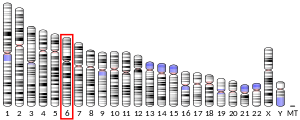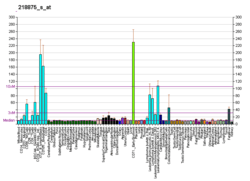FBXO5
F-box only protein 5 is a protein that in humans is encoded by the FBXO5 gene.[5][6][7]
Function
This gene encodes a member of the F-box protein family which is characterized by an approximately 40 amino acid motif, the F-box. The F-box proteins constitute one of the four subunits of the ubiquitin protein ligase complex called SCFs (SKP1-cullin-F-box), which function in phosphorylation-dependent ubiquitination. The F-box proteins are divided into 3 classes: Fbws containing WD-40 domains, Fbls containing leucine-rich repeats, and Fbxs containing either different protein-protein interaction modules or no recognizable motifs. The protein encoded by this gene belongs to the Fbxs class. This protein is similar to xenopus early mitotic inhibitor-1 (Emi1), which is a mitotic regulator that interacts with Cdc20 and inhibits the anaphase promoting complex.[7] Moreover, Emi1 also assembles a CRL1 complex that targets RAD51 for ubiquitin-mediated degradation.[8]
Disease
Gene and protein expression of FBXO5/Emi1 are increased in many human cancers and increased expression has been shown to cause chromosome instability and cancer.[9]
References
- GRCh38: Ensembl release 89: ENSG00000112029 - Ensembl, May 2017
- GRCm38: Ensembl release 89: ENSMUSG00000019773 - Ensembl, May 2017
- "Human PubMed Reference:". National Center for Biotechnology Information, U.S. National Library of Medicine.
- "Mouse PubMed Reference:". National Center for Biotechnology Information, U.S. National Library of Medicine.
- Cenciarelli C, Chiaur DS, Guardavaccaro D, Parks W, Vidal M, Pagano M (October 1999). "Identification of a family of human F-box proteins". Current Biology. 9 (20): 1177–9. doi:10.1016/S0960-9822(00)80020-2. PMID 10531035.
- Winston JT, Koepp DM, Zhu C, Elledge SJ, Harper JW (October 1999). "A family of mammalian F-box proteins". Current Biology. 9 (20): 1180–2. doi:10.1016/S0960-9822(00)80021-4. PMID 10531037.
- "Entrez Gene: FBXO5 F-box protein 5".
- Marzio A, Puccini J, Kwon Y, Maverakis NK, Arbini A, Sung P, et al. (January 2019). "The F-Box Domain-Dependent Activity of EMI1 Regulates PARPi Sensitivity in Triple-Negative Breast Cancers". Molecular Cell. 73 (2): 224–237.e6. doi:10.1016/j.molcel.2018.11.003. PMC 6995265. PMID 30554948.
- Vaidyanathan S, Cato K, Tang L, Pavey S, Haass NK, Gabrielli BG, Duijf PH (October 2016). "In vivo overexpression of Emi1 promotes chromosome instability and tumorigenesis". Oncogene. 35 (41): 5446–5455. doi:10.1038/onc.2016.94. PMID 27065322.
- Hsu JY, Reimann JD, Sørensen CS, Lukas J, Jackson PK (May 2002). "E2F-dependent accumulation of hEmi1 regulates S phase entry by inhibiting APC(Cdh1)". Nature Cell Biology. 4 (5): 358–66. doi:10.1038/ncb785. PMID 11988738.
- Cenciarelli C, Chiaur DS, Guardavaccaro D, Parks W, Vidal M, Pagano M (October 1999). "Identification of a family of human F-box proteins". Current Biology. 9 (20): 1177–9. doi:10.1016/S0960-9822(00)80020-2. PMID 10531035.
Further reading
- Gubin AN, Njoroge JM, Bouffard GG, Miller JL (July 1999). "Gene expression in proliferating human erythroid cells". Genomics. 59 (2): 168–77. doi:10.1006/geno.1999.5855. PMID 10409428.
- Chiaur DS, Murthy S, Cenciarelli C, Parks W, Loda M, Inghirami G, et al. (2000). "Five human genes encoding F-box proteins: chromosome mapping and analysis in human tumors". Cytogenetics and Cell Genetics. 88 (3–4): 255–8. doi:10.1159/000015532. PMID 10828603.
- Reimann JD, Freed E, Hsu JY, Kramer ER, Peters JM, Jackson PK (June 2001). "Emi1 is a mitotic regulator that interacts with Cdc20 and inhibits the anaphase promoting complex". Cell. 105 (5): 645–55. doi:10.1016/S0092-8674(01)00361-0. PMID 11389834.
- Reimann JD, Jackson PK (April 2002). "Emi1 is required for cytostatic factor arrest in vertebrate eggs". Nature. 416 (6883): 850–4. doi:10.1038/416850a. PMID 11976684.
- Hsu JY, Reimann JD, Sørensen CS, Lukas J, Jackson PK (May 2002). "E2F-dependent accumulation of hEmi1 regulates S phase entry by inhibiting APC(Cdh1)". Nature Cell Biology. 4 (5): 358–66. doi:10.1038/ncb785. PMID 11988738.
- Li Z, Hu CY, Mo BQ, Xu JD, Zhao Y (April 2003). "[Effect of beta-carotene on gene expression of breast cancer cells]". AI Zheng = Aizheng = Chinese Journal of Cancer. 22 (4): 380–4. PMID 12703993.
- Margottin-Goguet F, Hsu JY, Loktev A, Hsieh HM, Reimann JD, Jackson PK (June 2003). "Prophase destruction of Emi1 by the SCF(betaTrCP/Slimb) ubiquitin ligase activates the anaphase promoting complex to allow progression beyond prometaphase". Developmental Cell. 4 (6): 813–26. doi:10.1016/S1534-5807(03)00153-9. PMID 12791267.
- Moshe Y, Boulaire J, Pagano M, Hershko A (May 2004). "Role of Polo-like kinase in the degradation of early mitotic inhibitor 1, a regulator of the anaphase promoting complex/cyclosome". Proceedings of the National Academy of Sciences of the United States of America. 101 (21): 7937–42. doi:10.1073/pnas.0402442101. PMC 419535. PMID 15148369.
- Hansen DV, Loktev AV, Ban KH, Jackson PK (December 2004). "Plk1 regulates activation of the anaphase promoting complex by phosphorylating and triggering SCFbetaTrCP-dependent destruction of the APC Inhibitor Emi1". Molecular Biology of the Cell. 15 (12): 5623–34. doi:10.1091/mbc.E04-07-0598. PMC 532041. PMID 15469984.
- Rual JF, Venkatesan K, Hao T, Hirozane-Kishikawa T, Dricot A, Li N, et al. (October 2005). "Towards a proteome-scale map of the human protein-protein interaction network". Nature. 437 (7062): 1173–8. doi:10.1038/nature04209. PMID 16189514.
- Eldridge AG, Loktev AV, Hansen DV, Verschuren EW, Reimann JD, Jackson PK (January 2006). "The evi5 oncogene regulates cyclin accumulation by stabilizing the anaphase-promoting complex inhibitor emi1". Cell. 124 (2): 367–80. doi:10.1016/j.cell.2005.10.038. PMID 16439210.
- Lehman NL, Verschuren EW, Hsu JY, Cherry AM, Jackson PK (July 2006). "Overexpression of the anaphase promoting complex/cyclosome inhibitor Emi1 leads to tetraploidy and genomic instability of p53-deficient cells". Cell Cycle. 5 (14): 1569–73. doi:10.4161/cc.5.14.2925. PMID 16861914.
- Miller JJ, Summers MK, Hansen DV, Nachury MV, Lehman NL, Loktev A, Jackson PK (September 2006). "Emi1 stably binds and inhibits the anaphase-promoting complex/cyclosome as a pseudosubstrate inhibitor". Genes & Development. 20 (17): 2410–20. doi:10.1101/gad.1454006. PMC 1560415. PMID 16921029.
- Marangos P, Verschuren EW, Chen R, Jackson PK, Carroll J (January 2007). "Prophase I arrest and progression to metaphase I in mouse oocytes are controlled by Emi1-dependent regulation of APC(Cdh1)". The Journal of Cell Biology. 176 (1): 65–75. doi:10.1083/jcb.200607070. PMC 2063628. PMID 17190794.




